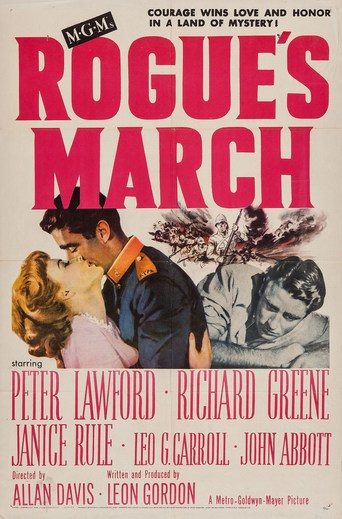

Terrible acting, screenplay and direction.
... View MoreDreadfully Boring
... View MoreThrough painfully honest and emotional moments, the movie becomes irresistibly relatable
... View MoreThe movie really just wants to entertain people.
... View MoreFirst off, actually filming in the Khyber Pass was really interesting especially considering the history and the current events. The acting was all right and nothing special. However, like a John Ford movie, the scenery and location are the real actors. To film where the actual events took place was a real thrill. The whole British military experience was also a thrill. Even though a reviewer mentioned the uniforms were not accurate for the period, I thought they were great. To see the training and what they went through was also a thrill. Although, some scenes shown, the men were using a Mauser bolt action type of rifle I do not think was accurate. I thought they used Martini Henry rifles but I could be wrong. I did see some bolt action Enfield rifles too. The battle scene was the most exciting. It showed a camel being used to take a wounded officer back (you will see what I mean). Then to see the soldiers using camels and mules to transport cannons and other weapons that were taken apart and transported on mule back. They showed cannons in pieces on the backs of the animals and then the men, who were military trained, take the cannons, assemble them, load, and actually shoot them. Some scenes the cannons fired and no recoil but some were loaded, fired, and then the cannons recoiled and almost flip over. This was the real thing. When I say assemble, I mean, the cannon barrels were in two pieces, then screwed together and a band in the middle tightened down with a big screw. The wheels put on, the men readied it to fire and then fired. To me, skip the first half and just watch the battle scene and you will be amazed.
... View More---SPOILER---In this period picture set in the Indian "raj" in the mid-1800s, Peter Lawford is a British army officer framed for espionage by Russian spies and drummed out of the army. He escapes from the police on his way to prison and makes his way to India to gather evidence to clear himself, a task he figures to accomplish by enlisting in the army under a different name. A variation on the old "Four Feathers" story, this low-budgeter from MGM can't make up its mind whether it's a thriller (Lawford trying to clear his name and find the real spies) or an action picture (the British fighting rebellious Afghan tribesmen in the Khyber Pass) and doesn't really succeed at either--you know that Lawford's going to clear himself (he does) and that the British army will win the day (they do). There's some odd casting (Janice Rule is Lawford's British sweetheart but doesn't even try to hide her American accent, Australian actor Michael Pate plays a Cockney soldier with a laughably exaggerated Cockney accent, American actor Richard Hale--who often played Indian chiefs in westerns--plays a Russian spymaster in the same kind of chopped, singsong manner in which he played Indians), and the picture overall is stiff and mechanical; a burst of action at the end isn't particularly well done (although it was filmed on location at the Khyber Pass and uses hundreds of extras), and even Lawford's charm, good looks and way with a line can't really save it.It's a bit better than most of the innumerable period "action" clunkers Sam Katzman was churning out at Columbia--several of them with the same setting as this picture--at around the same time, but that's about all that can be said for it.
... View MorePeter Lawford is set up by Russian spies, accused of treason, and drummed out of the British Army on the Northwest Frontier in this well made if implausible MGM programmer. So what does our dapper hero do? He shaves off his ridiculous moustache, of course, and joins up again, just in time to put the kibosh on the Tsar's plot. Rogue's March is an intriguing picture that will have viewers considering the current historical situation. Shot on location in and around India's Khyber Pass, the film portrays the Great Game struggle for control of Afghanistan, a struggle that was reignited in the late twentieth century and resulted in the rise of the Taliban and all that followed. The location footage and action sequences are extremely well shot, making up for the film's many inadequacies in other departments, and it would be fascinating to learn how MGM got access to the region and why it decided to shoot a second feature half way around the world. Worth a look for action fans.
... View MoreThere is a minor genre connected to war films of "proving" or "redeeming" films: Where the hero is branded coward or traitor and has to try to show he's been wronged. The best examples of these are the original FOUR FEATHERS (1939) and THE LIFE OF EMILE ZOLA (1938)[about the Dreyfus Case]. ROUGUES MARCH (1953) is a poor cousin of the other films, as it chronicles Peter Lawford's attempts to show he was framed for treason in India. The best moment in the film is when the actual traitor (John Abbott) is drowned by his Russian agent associates. The climax is when Lawford, after he has gotten his proof and presents it to his commanding officer is informed by that officer that the British Army knew the charges were false to begin with. That gives you a pretty good idea of the value of this film. Oh, as the commanding officer is Leo G. Carroll, perhaps you can see his performance here as a preperation for his U.S. spymaster handling Cary Grant in NORTH BY NORTHWEST (1959).
... View More